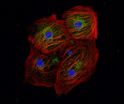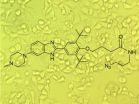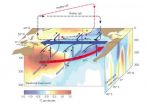(Press-News.org) (Memphis, Tenn. – February 10, 2014) St. Jude Children's Research Hospital scientists have identified a signature immune response that might help doctors identify which newly diagnosed influenza patients are most likely to develop severe symptoms and suffer poor outcomes. The findings also help explain why infants and toddlers are at elevated risk for flu complications. The research appears in the upcoming issue of the American Journal of Respiratory and Critical Care Medicine.
The discovery came after investigators tracked flu infections for 28 days in 84 individuals with community-acquired influenza. The study is still underway. This report focused on the 2009-2010 and 2010-2011 flu seasons.
Researchers found that patients with elevated levels of three particular immune system regulators, or cytokines, early in the infection were more likely to develop severe flu symptoms and to be hospitalized than patients with lower levels of the same regulators. Study participants ranged in age from 3 weeks to 71 years old and included 41 infants and toddlers aged 23 months or younger.
The cytokine levels early in the infection were predictive of flu-related complications regardless of patient age, flu strain, the ability of the virus to replicate and other factors. The cytokines involved help to regulate inflammation driven by the innate immune response. The innate immune system serves as the frontline of the body's defense against flu and other threats until antibodies and T cells are ready to provide a more targeted defense.
Study participants were recruited by research collaborators at Le Bonheur Children's Medical Center, a general children's hospital in Memphis, where patients are still being enrolled in the study. Researchers also plan to check for immune signatures in flu patients from sites in the U.S., Egypt, Colombia and other nations.
"Patients in this study could handle the flu virus and clear it from their lungs in a week to 10 days. The problem for patients with this immune signature is likely the inflammatory environment in their airways created by the innate immune system in response to the virus," said corresponding author Paul Thomas, Ph.D., an assistant member of the St. Jude Department of Immunology. "Clinically, we need to explore targeted therapies to address this problem separately from efforts to clear the virus."
The findings provide insight into why the benefits of the antiviral drug oseltamivir diminish early in the infection. "This drug helps get rid of the virus, but these patients do not appear to have a problem with that," Thomas explained.
Flu remains a leading cause of illness and death worldwide. In this study, 19 patients were hospitalized, including four who were admitted to an intensive care unit.
For this study, researchers tracked both the flu infection and the resulting immune response through blood, nasal swabs and nasal wash samples collected from patients with laboratory-confirmed flu. Sampling began when patients sought medical attention for flu symptoms and was repeated on days 3, 7, 10 and 28. Along with measuring levels of flu virus in the nose and sinuses, researchers measured 42 cytokines and antibodies against circulating flu viruses.
This is one of the first studies to examine the immune response in both the blood and in the nose and sinuses, where the infection begins. The patients included 24 who qualified as high risk for flu complications due to asthma and certain other underlying medical conditions. Similar sampling was conducted on 126 volunteers recruited from the households of flu patients.
The testing showed children and adults were equally successful at eliminating the virus regardless of the subtype. In fact, based on cytokine levels in the blood, nose and sinuses of patients, children mounted a more aggressive inflammatory response than adults. "The fact that the innate immune response was stronger in the airways of children than adults was a surprise. Previous studies using different measures reported that children mounted a weaker immune response," said first author Christine Oshansky, Ph.D., a St. Jude postdoctoral fellow. In this study, the hyperactive immune response diminished with age, but Thomas said it may help explain why toddlers and infants are more likely to develop severe flu symptoms. Normal genetic variation might play a role in the innate immune response, he added.
When researchers dissected the inflammatory response, they found that elevated nasal levels of the cytokines MCP-3 and interferon alpha 2 (IFNa2) and elevated blood levels of interleukin 10 (IL-10) at diagnosis predicted more severe symptoms later. Increased blood levels of IL-10 and MCP-3, as well as interleukin-6, at diagnosis predicted hospitalization later. MCP-3 and IFNa2 promote inflammation. IL-10 suppresses inflammation. Elevated IL-10 levels often signal that the body is trying to shut down the inflammatory response.
Researchers also found evidence linking inflammatory cytokine levels to white blood cells called monocytes that are recruited to the site of the infection. Through cytokine secretion and other activities, different types of monocytes have the ability to orchestrate a variety of inflammatory responses. Some responses are likely beneficial, but some may hinder patient recovery. Work has begun to better understand what regulates production and movement of different monocyte populations as a way to better explain differences in the inflammatory response to flu.
INFORMATION:
The other authors are Andrew Gartland and Tomer Hertz, both of the Fred Hutchinson Cancer Research Center, Seattle; Sook-San Wong, Trushar Jeevan, , Miguela Caniza and Richard Webby, all of St. Jude; David Wang, formerly of St. Jude; and Philippa Roddam and John DeVincenzo, both of the University of Tennessee School of Medicine and Le Bonheur.
The study was funded in part by the National Institute of Allergy and Infectious Diseases and ALSAC.
St. Jude Media Relations Contacts
Carrie Strehlau
desk: (901) 595-2295
cell: (901) 297-9875
carrie.strehlau@stjude.org
Summer Freeman
desk: (901) 595-3061
cell: (901) 297-9861
summer.freeman@stjude.org
Researchers discover immune signature that predicts poor outcome in influenza patients
A study led by St. Jude Children's Research Hospital identifies factors that predict flu severity in patients and sets the stage for more effective therapies to prevent flu complications and deaths
2014-02-10
ELSE PRESS RELEASES FROM THIS DATE:
How do polar bears stay warm? Research finds an answer in their genes
2014-02-10
BUFFALO, N.Y. — In the winter, brown and black bears go into hibernation to conserve energy and keep warm.
But things are different for their Arctic relative, the polar bear. Within this high-latitude species, only pregnant females den up for the colder months.
So how do the rest survive the extreme Arctic winters?
New research points to one potential answer: genetic adaptations related to the production of nitric oxide, a compound that cells use to help convert nutrients from food into energy or heat.
In a new study, a team led by the University at Buffalo reports ...
Experimental care program keeps people with dementia at home longer, study shows
2014-02-10
An 18-month pilot program that brought resources and counselors to elderly Baltimore residents with dementia and other memory disorders significantly increased the length of time they lived successfully at home, according to Johns Hopkins researchers. Staying at home was a clear preference for most of those who participated in the study.
"The project demonstrated that we were able to help such people age in place without sacrificing their quality of life," says study leader Quincy Miles Samus, Ph.D., an assistant professor of psychiatry and behavioral sciences at the ...
Research reveals the give and take of urban temperature mitigating technologies
2014-02-10
TEMPE, Ariz. – Life in a warming world is going to require human ingenuity to adapt to the new realities of Earth. Greenhouse-gas induced warming and megapolitan expansion are both significant drivers of our warming planet. Researchers are now assessing adaptation technologies that could help us acclimate to these changing realities.
But how well these adaptation technologies – such as cool roofs, green roofs and hybrids of the two – perform year round and how this performance varies with place remains uncertain.
Now a team of researchers, led by Matei Georgescu, ...
The genetic origins of high-altitude adaptations in Tibetans
2014-02-10
Genetic adaptations for life at high elevations found in residents of the Tibetan plateau likely originated around 30,000 years ago in peoples related to contemporary Sherpa. These genes were passed on to more recent migrants from lower elevations via population mixing, and then amplified by natural selection in the modern Tibetan gene pool, according to a new study by scientists from the University of Chicago and Case Western Reserve University, published in Nature Communications on Feb. 10.
The transfer of beneficial mutations between human populations and selective ...
Study involving twin sisters provides clues for battling aggressive cancers
2014-02-10
CINCINNATI – Analyzing the genomes of twin 3-year-old sisters – one healthy and one with aggressive leukemia – led an international team of researchers to identify a novel molecular target that could become a way to treat recurring and deadly malignancies.
Scientists in China and the United States report their findings online Feb. 9 in Nature Genetics. The study points to a molecular pathway involving a gene called SETD2, which can mutate in blood cells during a critical step as DNA is being transcribed and replicated.
The findings stem from the uniquely rare opportunity ...
Genome editing goes hi-fi
2014-02-10
SAN FRANCISCO, CA—February 9, 2014—Sometimes biology is cruel. Sometimes simply a one-letter change in the human genetic code is the difference between health and a deadly disease. But even though doctors and scientists have long studied disorders caused by these tiny changes, replicating them to study in human stem cells has proven challenging. But now, scientists at the Gladstone Institutes have found a way to efficiently edit the human genome one letter at a time—not only boosting researchers' ability to model human disease, but also paving the way for therapies that ...
Cochlear implants -- with no exterior hardware
2014-02-10
Cochlear implants — medical devices that electrically stimulate the auditory nerve — have granted at least limited hearing to hundreds of thousands of people worldwide who otherwise would be totally deaf. Existing versions of the device, however, require that a disk-shaped transmitter about an inch in diameter be affixed to the skull, with a wire snaking down to a joint microphone and power source that looks like an oversized hearing aid around the patient's ear.
Researchers at MIT's Microsystems Technology Laboratory (MTL), together with physicians from Harvard Medical ...
Scientists invent advanced approach to identify new drug candidates from genome sequence
2014-02-10
JUPITER, FL—February 9, 2014—In research that could ultimately lead to many new medicines, scientists from the Florida campus of The Scripps Research Institute (TSRI) have developed a potentially general approach to design drugs from genome sequence. As a proof of principle, they identified a highly potent compound that causes cancer cells to attack themselves and die.
"This is the first time therapeutic small molecules have been rationally designed from only an RNA sequence—something many doubted could be done," said Matthew Disney, PhD, an associate professor at TSRI ...
Fight or flight? Vocal cues help deer decide during mating season
2014-02-10
Previous studies have shown that male fallow deer, known as bucks, can call for a mate more than 3000 times per hour during the rut (peak of the mating season), and their efforts in calling, fighting and mating can leave them sounding hoarse.
In this new study, published today (10 February) in the journal Behavioral Ecology, scientists were able to gauge that fallow bucks listen to the sound quality of rival males' calls and evaluate how exhausted the caller is and whether they should fight or keep their distance.
"Fallow bucks are among the most impressive vocal athletes ...
Pacific trade winds stall global surface warming -- for now
2014-02-10
Heat stored in the western Pacific Ocean caused by an unprecedented strengthening of the equatorial trade winds appears to be largely responsible for the hiatus in surface warming observed over the past 13 years.
New research published today in the journal Nature Climate Change indicates that the dramatic acceleration in winds has invigorated the circulation of the Pacific Ocean, causing more heat to be taken out of the atmosphere and transferred into the subsurface ocean, while bringing cooler waters to the surface.
"Scientists have long suspected that extra ocean ...
LAST 30 PRESS RELEASES:
Tracing the quick synthesis of an industrially important catalyst
New software sheds light on cancer’s hidden genetic networks
UT Health San Antonio awarded $3 million in CPRIT grants to bolster cancer research and prevention efforts in South Texas
Third symposium spotlights global challenge of new contaminants in China’s fight against pollution
From straw to soil harmony: International team reveals how biochar supercharges carbon-smart farming
Myeloma: How AI is redrawing the map of cancer care
Manhattan E. Charurat, Ph.D., MHS invested as the Homer and Martha Gudelsky Distinguished Professor in Medicine at the University of Maryland School of Medicine
Insilico Medicine’s Pharma.AI Q4 Winter Launch Recap: Revolutionizing drug discovery with cutting-edge AI innovations, accelerating the path to pharmaceutical superintelligence
Nanoplastics have diet-dependent impacts on digestive system health
Brain neuron death occurs throughout life and increases with age, a natural human protein drug may halt neuron death in Alzheimer’s disease
SPIE and CLP announce the recipients of the 2025 Advanced Photonics Young Innovator Award
Lessons from the Caldor Fire’s Christmas Valley ‘Miracle’
Ant societies rose by trading individual protection for collective power
Research reveals how ancient viral DNA shapes early embryonic development
A molecular gatekeeper that controls protein synthesis
New ‘cloaking device’ concept to shield sensitive tech from magnetic fields
Researchers show impact of mountain building and climate change on alpine biodiversity
Study models the transition from Neanderthals to modern humans in Europe
University of Phoenix College of Doctoral Studies releases white paper on AI-driven skilling to reduce burnout and restore worker autonomy
AIs fail at the game of visual “telephone”
The levers for a sustainable food system
Potential changes in US homelessness by ending federal support for housing first programs
Vulnerability of large language models to prompt injection when providing medical advice
Researchers develop new system for high-energy-density, long-life, multi-electron transfer bromine-based flow batteries
Ending federal support for housing first programs could increase U.S. homelessness by 5% in one year, new JAMA study finds
New research uncovers molecular ‘safety switch’ shielding cancers from immune attack
Bacteria resisting viral infection can still sink carbon to ocean floor
Younger biological age may increase depression risk in older women during COVID-19
Bharat Innovates 2026 National Basecamp Showcases India’s Most Promising Deep-Tech Ventures
Here’s what determines whether your income level rises or falls
[Press-News.org] Researchers discover immune signature that predicts poor outcome in influenza patientsA study led by St. Jude Children's Research Hospital identifies factors that predict flu severity in patients and sets the stage for more effective therapies to prevent flu complications and deaths






